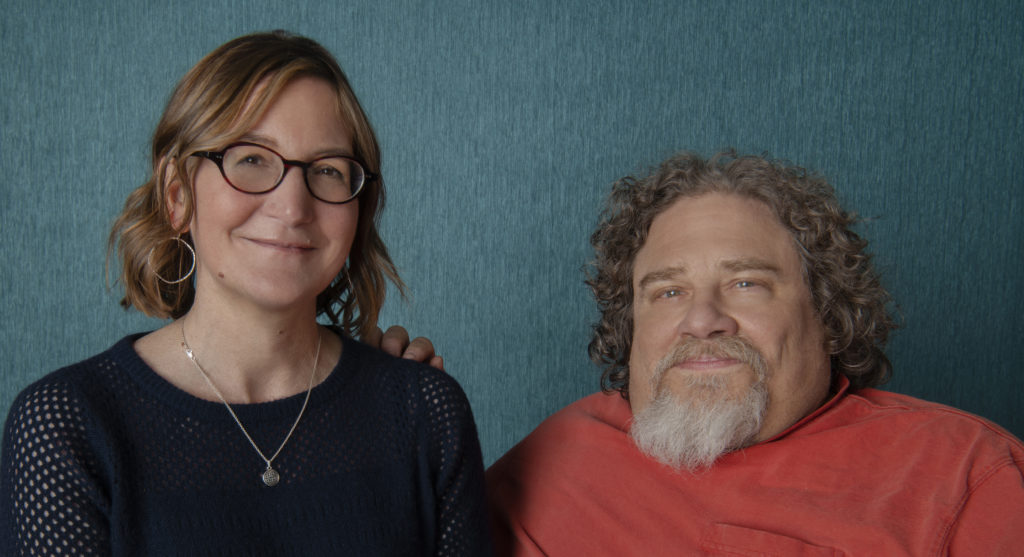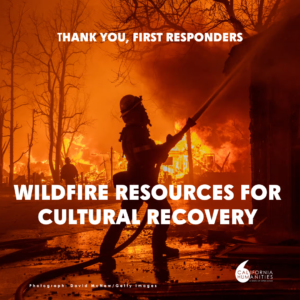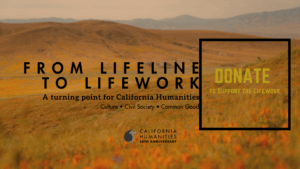We at California Humanities have been excitedly following the trajectory of CRIP CAMP since we first funded the project through a California Documentary Project grant back in 2018. So far, the film was selected to be a part of former president Barack Obama and Michelle Obama’s Higher Ground Productions’ slate of programming for Netflix, it premiered at the Sundance Film Festival on opening night, won the Audience Award there for US Documentary, and was released on Netflix to a wide audience in March. We reached out to the co-directors, Nicole Newnham and Jim LeBrecht, whose story is also central to the film, to learn more about their experiences behind the scenes.
California Humanities: Take us back to the beginning. Where would you say the idea for this project come from at first? And when during the process did you begin to realize the kind of reception and distribution opportunities that it might have?
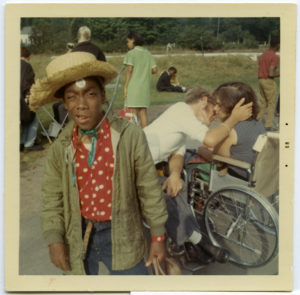
Jim LeBrecht: Having worked in audio post production for over 25 years, I’ve had the pleasure to see and work on some excellent documentaries over time. But I rarely ever saw docs about the lived experience of people with disabilities. I thought that the story of Camp Jened and the exodus of campers and staff from the New York City area to Berkeley in the mid 1970s could be an important story. Maybe, just maybe, there was a connection to the camp and the disabled civil rights and independent living movement that was blossoming in the Bay Area and the rest f the country.
It was a chance remark at the end of a lunch with Nicole five years ago that got the ball rolling. I have worked with Nicole over 15 years as the sound designer and mixer on three of her feature length documentaries. I loved her work and wanted to pitch some film ideas to her over lunch. As we started our way back to the building where I had Berkeley Sound Artists, I told her that the film that I really wanted to make was one about my summer camp. I started to tell her about this place and the hippies and the freedom I had there, and her interest was piqued. When she saw the Facebook page full of photos of the camp back in the early 1970s, she was hooked.
Nicole Newnham: I was hooked because seeing kids with disabilities goofing around, filled with such joy and experiencing such freedom and community together was so delightful and infectious and also something I realized that we never see represented in the media. I’ve made previous films (Sentenced Home, Revolutionary Optimists) about young people making change. When Jim suggested that the thought that the camp experience was somehow linked to the disability rights and independent living movements that blossomed in Northern California in the 1970’s, my heart started to pound. It was only after a lot of discussion and research (and considering bringing the camp back to life with hybrid scenes) that we tracked down the People’s Video Theater and found their extraordinary footage (some of it shot by Jim!) which became the heart and soul of the film.
Jim LeBrecht: As we worked gathering materials and starting to shoot, we had some good clips and a trailer to show folks. The reaction to those materials was almost unanimous. People flipped over the black and white video footage of the camp in 1971. And for some people, seeing our fundraising trailer (edited by Andrew Gersh) changed their perception of disability! When we went to the film market at Independent Filmmaker Project in 2017, the interest was high. It was at that point that we thought we had something that was capable of attracting audiences.
California Humanities: Of course, the project is titled CRIP CAMP, and the trailers, and many of the reviews, focus on the camp aspect of it—a summertime haven for teens with disabilities where they got into all sorts of trouble and built bonds. However, we got involved because this is also a California story. What’s the connection to California and why was that aspect of the story so important to tell?
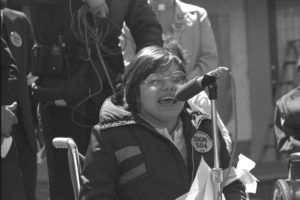
Jim LeBrecht: In the early 1970s, Berkeley became the center of the independent living movement. With the establishment of the first Center for Independent Living (CIL) close to the UC campus, Berkeley became the testing and proving ground for fully integrating people with disabilities into mainstream society. It was CIL that drew disabled civil rights legend Judith Heumann to Berkeley at Ed Roberts request. When Judy told us from camp about Berkeley, it was like a clarion call for us to migrate to the West Coast to establish a new life for ourselves. That’s one major part of our story. The other one was the 26-day takeover of the offices of the Department of Health, Education, and Welfare in San Francisco. For close to a month, demonstrators stayed in the building to protest the Carter administration’s refusal to sign and release regulations that had far reaching civil rights protections for those with disabilities. The story is deeper than the location of the sit-in. It was because of the culture of San Francisco that the demonstrators could survive living in the building for so long. The Black Panthers brought in food. Support came from San Francisco’s Glide Memorial Church. And local Gay and Lesbian organizations helped out, as well. And a big help came from the local unions. At that time, being politically involved in a liberation movement was something that many residents participated in. It was almost a badge of honor to have been arrested for some act of civil disobedience. To this day, the legacy of that movement can be felt throughout California and the rest of the world. The Ed Roberts Center in Berkeley is in a lot of ways a historical building in that it pays homage to Ed and the other fighters that gathered in Berkeley to gain our rights and independence.
Nicole Newnham: Jim and I both wanted the film to be a love letter to the radical, collectivist, world-changing culture of the Bay Area of that time. Like Camp Jened, the Bay Area represented the first experience of freedom to be themselves for so many people. For the Jenedians, it was the place where they could try to build something closer to what they had experienced at Jened in the larger world. Jim and I individually found freedom here and have built our adult lives and careers here. So being able to play a role in telling one of the Bay Area’s seminal and great civil rights stories was incredibly meaningful.
California Humanities: California Humanities recently released our equity values statement. As we worked on that, we were noticing that it seems disability and accessibility are becoming much more of a focus in conversations about equity and justice. What role does a film like CRIP CAMP play in this growing conversation?
Jim LeBrecht: It has been disheartening to hear about all of the diversity and inclusion campaigns that started becoming commonplace a few years ago. People were recognizing the need and value of embracing women, people of color and members of the LGBTQ+ communities in their business, guilds and companies. But those with disabilities weren’t on the radar of those same entities. Why was that? Why didn’t those people see that we were not only not at the table for these discussions, but we weren’t even in the building! It’s our hope that CRIP CAMP starts meaningful conversations that have needed to happen for a long time. We hope that the film forces people to look long and hard at their prejudices and fears against those with disabilities. If we can help reframe how the disabled are perceived by those with and without disabilities, then we’ll have more active voices rising up and organizations that will widen their minds and doorways for us to come in.
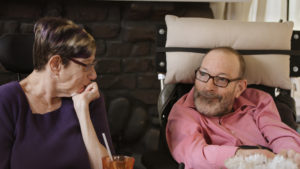
Nicole Newnham: CRIP CAMP is only one story, about one group of people, and there are so many other stories that need to be heard. It’s important that the conversation around the film doesn’t stay focused in the past. Our impact campaign—which will be active throughout the year—is led by and brings to the foreground emerging and established leaders from the disability justice movement. We hope that through supporting and lifting up cutting edge voices and stories from today’s movement, we can really make a change in people’s perception of disability as a social justice issue.
California Humanities: So many narratives around disability, particularly young people with disabilities, have a serious tone. CRIP CAMP highlights a lot of irreverence and joy, in addition to dealing with more solemn themes. What role does humor play in the telling of this story?
Jim LeBrecht: It’s fair to say that humor can be found in any culture. For many of us, disability is our culture. It is our common ground, our shared experience. So it makes sense that we have our own humor and other artistic expressions that are steeped in our experiences. Humor is a great way to express anger at injustices. It’s an outlet that creates comradery. But the other side of the coin is that humor is a way to take fear away from those on the outside. If I’m being irreverent or joking about my disability, it’s a signal that I’m comfortable about my particular situation. In CRIP CAMP you see a lot of joy and humor. Where else could we joke about the things that they outside world was so uncomfortable about?
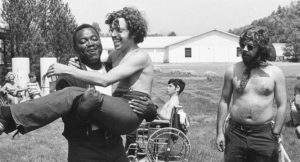
Nicole: We often said that this film should feel like a party that people really wanted to be invited into. So people would immediately know this story was the opposite of the usual tragedy, or “inspiration porn” tropes that so often are lifted up around disability. Also, in the face of oppression, joy is radical, and a vital part of community building and change making.
California Humanities: One of the themes of the film is about people who often are isolated building community. There’s also been this community that has formed around the film: funders, celebrities, activists, and now audiences. What do you think it’s important for people to know about the collaboration that it takes to make a film like yours?
Jim LeBrecht: I think that as filmmakers, you have to show that there is meaning behind your film. With a clear vision about why your film should be made and seen, it’s easier (but still not easy) to find funders and supporters. You have to craft a story that is compelling, taking your audience into a world they rarely if ever see. And, I suppose, the most compelling stories that are filled with drama, a fight, humor, and a look at the world unlike one has seen before.
Nicole Newnham: I think the line between doc filmmaker and organizer is very fine. That’s one thing I’ve always loved about the Bay Area doc community: it operates a bit like a movement. Every film is made by a family of those who recognize and support the birth of its story out into the world. Because we were co-directing, across different identities and perspectives (male/female, non-disabled/disabled) a real respect and openness and the ability to really listen and support each other was essential. We kept that going in our work with our editors which was intensely collaborative and trusting of what each person brought to the table, and in our work with our brilliant executive producers. I feel this is a film of a lifetime and Jim and I were both so lucky to be able to draw on people from the film, funding, philanthropic and activist communities that we’ve been working with for 25 years.
California Humanities: In addition to Sundance, Higher Ground, and Netflix, what are some milestones for you in terms of where CRIP CAMP has gone? What has working with big names like these been for you?
Nicole Newnham: We also managed to squeeze in being the opening night film for MOMA’s documentary fortnight, which was a real honor, were selected for True/False and won the Zeno Mountain Award at the Miami Film Festival before our festival run and planned theatrical release was cut short! From our first discussions with Priya & Tonia at Higher Ground, it was obvious that we shared the same values and saw the same culture-changing potential in the power of this story of young change makers and grassroots organizing. We were blessed with the President and Mrs. Obama reviewing cuts of our film and giving insightful feedback. It’s been a true collaboration and we are so grateful to have such an extraordinary platform from which to tell this story.
Jim LeBrecht: This has been a remarkable experience. Truly. Coming under the wing of the Obama’s Higher Ground production company and working with Netflix has been a massively positive experience. Higher Ground has been very hands on with Nicole Newnham and me. The commitment and experience that both Priya Swaminathan and Tonia Davis from Higher Ground have given CRIP CAMP was an added boost to our already deft team of producers, editors, archivists and other artists. Netflix has been very supportive of our vision for the film, especially in how we wanted to execute accessibility for all to our film. Closed captions are available in 29 languages and they recorded audio descriptions in 17 languages. That’s well beyond the number of languages they typically do. They even produced a script of the film so that Deafblind people could experience CRIP CAMP.
California Humanities: What is next for the two of you?
Jim LeBrecht: I think we’re just starting to think about the future. There are avenues that the success of our film will open up for us. It’s going to be exciting, for sure, whatever the future brings. But it’s hard to imagine any project that will be as transformative and meaningful for us as CRIP CAMP has been.
Nicole Newnham: What Jim said!

